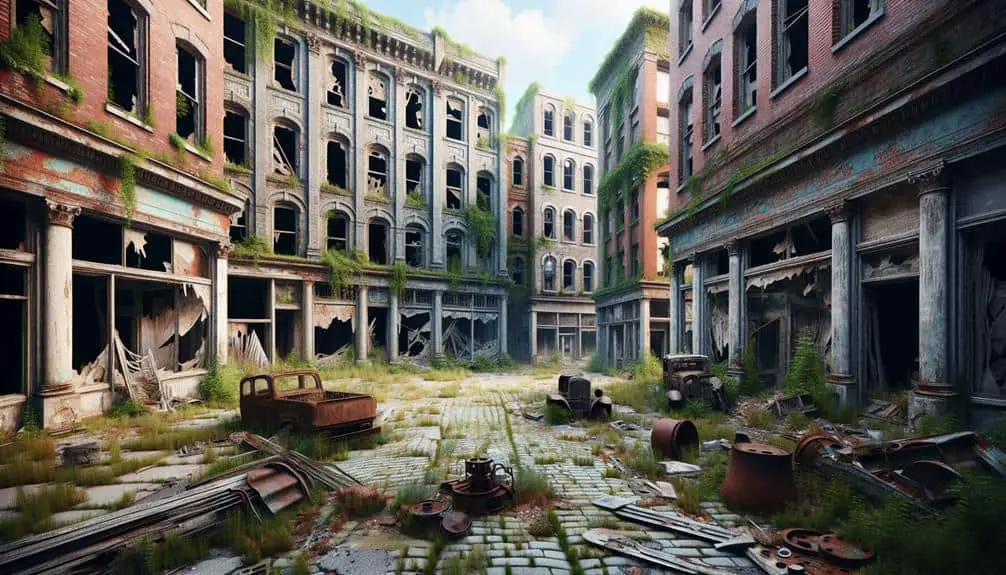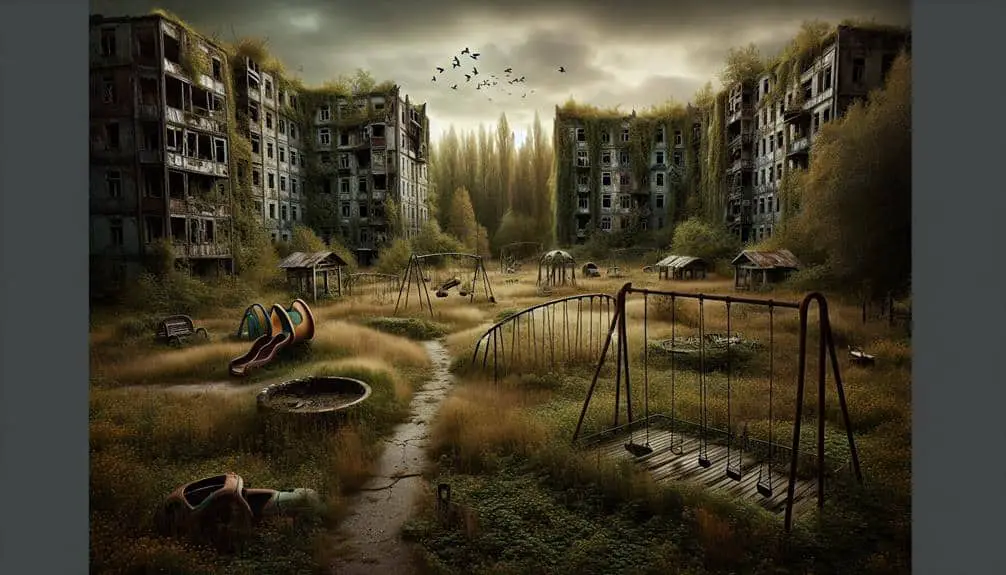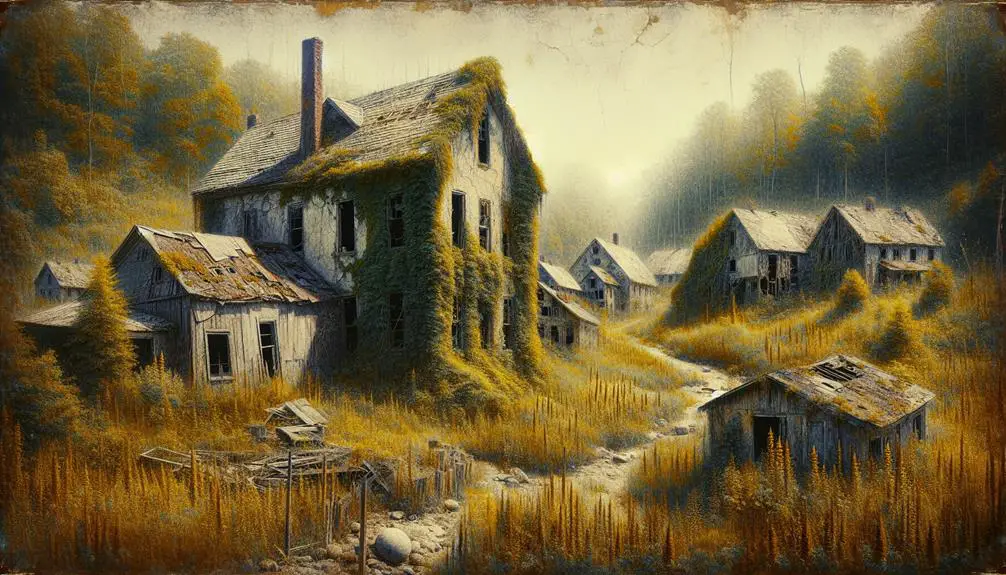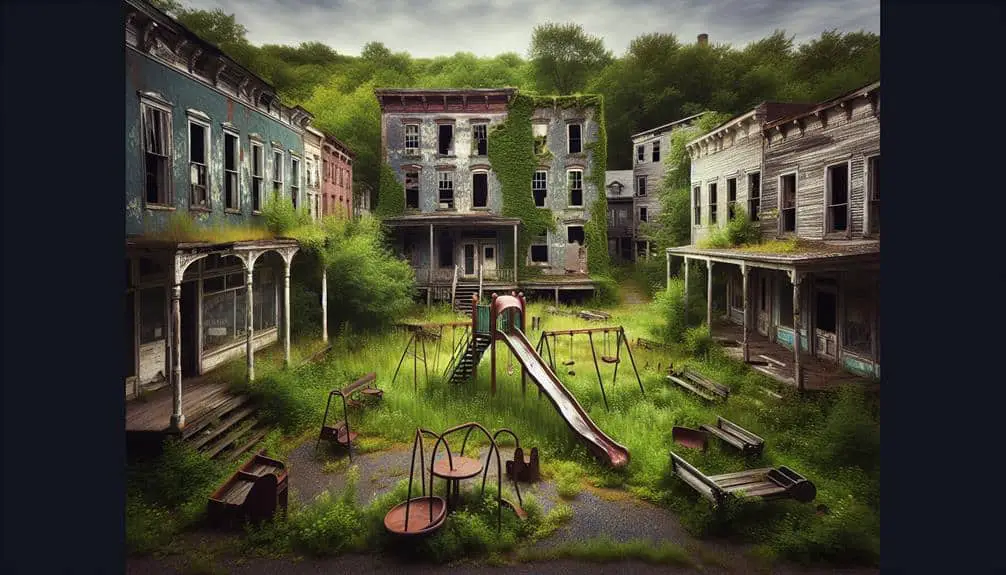In the United States, failed utopian communities hold a rich history of ambitious social experiments that sought to prioritize harmony, equality, and cooperation. Challenges like diverging interpretations of communal living principles and power struggles led to their decline. The abandoned utopian architectural legacy stands as a proof to these aspirations, offering insights into the evolution of utopian ideals. Efforts in restoration involve community engagement, sustainable practices, and repurposing structures for modern use. By exploring the revival of these ghost towns, you'll uncover a fascinating journey of preserving heritage and communal legacies.
Key Points
- Engage local communities in restoration efforts.
- Utilize sustainable practices for revitalization.
- Host events, workshops, and informational sessions.
- Encourage volunteer participation in clean-up and fundraising.
- Foster pride in preserving historical utopian heritage.
Origins of Utopian Settlements
The origins of utopian settlements trace back to the 18th and 19th centuries when idealistic groups sought to create self-sustaining communities based on shared values and beliefs. These communities aimed to break away from societal norms and experiment with new ways of communal living. The idea was to establish experimental societies that prioritized harmony, equality, and cooperation among members.
Communal living was at the core of these utopian settlements, with residents working together towards common goals and sharing resources. The concept of shared ownership and collective decision-making was central to their structure. These communities were often established in rural areas, away from the constraints of urban life, to foster a closer connection with nature and promote self-reliance.
The experimental nature of these societies led to a diverse range of practices and philosophies, with each community interpreting communal living in its unique way. Despite facing challenges and ultimately some failures, the ideals behind these utopian settlements continue to inspire individuals seeking alternative ways of living that prioritize freedom and cooperation.
Ideals Behind Failed Communities
Origins of utopian settlements in the 18th and 19th centuries often unraveled due to diverging interpretations of communal living principles, shedding light on the ideals behind failed communities. The essence of these failed utopian communities lay in their ambitious social experiments and the intricate web of community dynamics they sought to establish. At the core of these ideals was the belief in creating a society where equality, cooperation, and shared resources would flourish. However, as individuals with diverse backgrounds and beliefs came together to form these communities, clashes in ideologies and power struggles emerged, challenging the very foundations on which they were built.
The ideals behind these failed communities were rooted in a quest for a better way of living, driven by a desire to break free from societal norms and constraints. These social experiments aimed to redefine the traditional structures of society, offering a glimpse into alternative ways of organizing human existence. Yet, the complexities of human nature and the intricate dynamics of communal living often led to the unraveling of these utopian dreams, highlighting the delicate balance required to sustain such communities.
Challenges Faced by Utopias
Utopias encounter a myriad of challenges that test the feasibility of their ideals and the sustainability of their communal structures. One major challenge faced by utopian communities is the intricate web of social dynamics. Creating a harmonious environment where individuals with diverse backgrounds and beliefs coexist peacefully can be a challenging task. Conflicts arising from differing ideologies or personalities can destabilize the utopia's foundation.
- Social Dynamics: Balancing individual freedoms with the collective good can lead to internal tensions and power struggles within the community.
- Economic Sustainability: Ensuring the financial stability of a utopia is important for its survival. Generating sufficient income to support communal needs while maintaining equality can be a delicate balancing act.
- Environmental Pressures: Utopias often face challenges related to sustainability and resource management. Striking a balance between development and preservation is essential to prevent environmental degradation and maintain a healthy living environment for all inhabitants.
Navigating these challenges requires constant adaptation and a willingness to address issues as they arise to maintain the utopian vision.
Abandoned Utopian Architectural Legacy
Exploring the intricate web of social dynamics in utopian communities often leaves behind a fascinating legacy of abandoned utopian architecture. These architectural remnants stand as affirmations to the aspirations of the past and the challenges faced by these idealistic communities. The preservation of these structures isn't only important for historical significance but also for potential community revitalization projects.
Architectural preservation plays an essential role in understanding the evolution of utopian ideals and the impact they had on physical landscapes. These abandoned structures, whether grand communal buildings or modest living quarters, hold stories waiting to be told. By recognizing the value of preserving these architectural pieces, we can learn from the successes and failures of past utopian experiments.
Moreover, integrating these abandoned utopian architectural pieces into community revitalization projects can breathe new life into forgotten spaces. Repurposing these structures for modern use while honoring their historical significance allows for a harmonious blend of past and present. By embracing these architectural legacies, communities can create a bridge between history and progress, fostering a deeper connection to the collective dreams of the past.
Modern Efforts in Utopian Restoration
Modern endeavors in restoring utopian communities have sparked a resurgence of interest in preserving and revitalizing historical sites across the United States. Initiatives aimed at bringing back these abandoned utopian communities involve a blend of community engagement and sustainable practices to guarantee the longevity and success of these restoration projects.
- Community Engagement
- Involving local residents, historians, and enthusiasts in the restoration process fosters a sense of ownership and pride in preserving the community's heritage.
- Hosting community events, workshops, and informational sessions can educate the public about the historical significance of these utopian sites and garner support for restoration efforts.
- Encouraging volunteer participation in clean-up days, fundraising activities, and historical tours creates a sense of camaraderie and shared responsibility among community members.
Frequently Asked Questions
What Role Did Religion Play in the Creation of These Utopian Settlements?
Religious beliefs influenced the creation of utopian settlements by shaping social dynamics. People sought to live out their spiritual ideals collectively, fostering a sense of community and shared purpose. This bond often determined the success or failure of such ventures.
How Did the Economic Structure of These Failed Communities Contribute to Their Downfall?
Explore how economic structures within these communities created rifts, impacting social dynamics. Strained resources and unequal wealth distribution led to discontent. Understanding these imbalances is pivotal in unraveling the downfall of these failed utopian experiments.
Were There Any Significant Environmental Factors That Led to the Abandonment of These Utopian Towns?
Environmental degradation played a pivotal role in the demise of these utopian towns. Mismanagement of community resources, such as water scarcity and deforestation, led to irreversible damage. Lack of sustainable practices ultimately contributed to the abandonment of these once-thriving settlements.
What Impact Did the Architectural Design of These Abandoned Utopias Have on Future Urban Planning?
When contemplating the impact of architectural design from abandoned utopian towns on future urban planning, it's essential to acknowledge the potential for architectural influence to inspire community restoration, historical preservation, and innovative urban development strategies.
Are There Any Notable Success Stories of Modern Efforts to Revive and Restore Failed Utopian Communities in the United States?
In modern efforts to revive failed utopian communities in the United States, community engagement plays a vital role. Historical preservation, sustainable development, and cultural revitalization are key factors in successfully breathing new life into these abandoned spaces.



